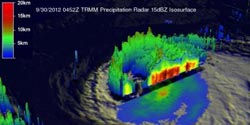NASA sees Nadine weaken to a tropical storm again

TRMM satellite data from Sept. 30 were used to make this 3-D view of Nadine from the northeast. Convective thunderstorms appear in the northwestern part of the hurricane were reaching to heights of about 12km (~7.5 miles).<br><br>Credit: SSAI/Hal Pierce<br>
Over the weekend of Sept. 29 and 30, Hurricane Nadine dramatically rebounded. On September 19, 2012 Nadine appeared to be dissipating quickly and was expected to become post-tropical but after over a week of meandering near the Azores, Nadine sprang to life again as a hurricane on Friday September 28, 2012.
NASA's Tropical Rainfall Measuring Mission (TRMM) satellite's path took it almost directly above hurricane Nadine on Sept. 30 at 0452 UTC (12:52 a.m. EDT) when it was still a hurricane.
At NASA's Goddard Space Flight Center in Greenbelt, Md. an enhanced infrared image from TRMM's Visible and InfraRed Scanner (VIRS) was overlaid with a rainfall analysis derived from TRMM's TRMM Microwave Imager (TMI) and Precipitation Radar (PR). The final image revealed that Nadine had a well-defined but ragged eye with the heaviest rainfall of about 50mm/hour (~2 inches) located on the western side of the hurricane.
TRMM PR data were used to also create a 3-D view from the northeast that showed convective thunderstorms in the northwestern part of the hurricane were reaching to heights of about 12km (~7.5 miles).
On Oct. 1 at 11 a.m. EDT, the center of Tropical Storm Nadine was 690 miles (1,110 km) west of the Azores near latitude 35.8 north and longitude 39.2 west. Maximum sustained winds have decreased to near 70 mph (110 kph). Nadine is moving toward the south-southeast near 5 mph (7 kph) and expected to do a counter-clockwise loop over the next day, turning southeast and east.
A Tropical Storm Watch is again in effect for the Azores.
Satellite data reveals that the strongest thunderstorms within Nadine are in the northern and eastern quadrants. Wind shear is increasing and sea surface temperatures are below the 80 degree Fahrenheit (26.6 Celsius) threshold needed to keep a tropical storm going, so weakening is expected.
Infrared imagery from NASA's Atmospheric Infrared Sounder (AIRS) instrument aboard the Aqua satellite show that sea surface temperatures near Nadine are around 23 Celsius (73.4 Fahrenheit), too cold to maintain a tropical storm.
According to the National Hurricane Center, tropical storm conditions are possible in the Azores by late Wednesday, Oct. 3.
Media Contact
More Information:
http://www.nasa.govAll latest news from the category: Earth Sciences
Earth Sciences (also referred to as Geosciences), which deals with basic issues surrounding our planet, plays a vital role in the area of energy and raw materials supply.
Earth Sciences comprises subjects such as geology, geography, geological informatics, paleontology, mineralogy, petrography, crystallography, geophysics, geodesy, glaciology, cartography, photogrammetry, meteorology and seismology, early-warning systems, earthquake research and polar research.
Newest articles

Superradiant atoms could push the boundaries of how precisely time can be measured
Superradiant atoms can help us measure time more precisely than ever. In a new study, researchers from the University of Copenhagen present a new method for measuring the time interval,…

Ion thermoelectric conversion devices for near room temperature
The electrode sheet of the thermoelectric device consists of ionic hydrogel, which is sandwiched between the electrodes to form, and the Prussian blue on the electrode undergoes a redox reaction…

Zap Energy achieves 37-million-degree temperatures in a compact device
New publication reports record electron temperatures for a small-scale, sheared-flow-stabilized Z-pinch fusion device. In the nine decades since humans first produced fusion reactions, only a few fusion technologies have demonstrated…





















